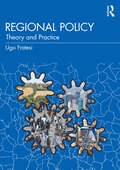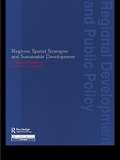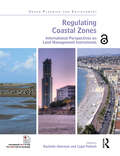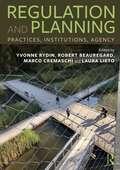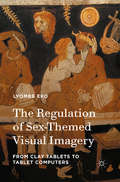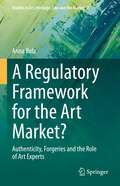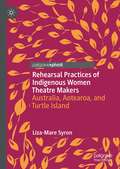- Table View
- List View
Regional Policy: Theory and Practice
by Ugo FratesiRegional policy is an essential in any government’s toolkit for promoting socioeconomic prosperity. It comes in many forms and can be used to target the development of weak and stronger regions. This textbook provides comprehensive and systematic coverage of regional policy, dealing with core theories and looking at contemporary challenges in practice, addressing regional policy across the world. Structured in four parts, the book opens with an exploration of regional policy’s characterisation, aims and rationale. The second part is devoted to issues of implementation and the instruments available to policymakers for intervention. The third part addresses regional policy evaluation, as well as statistics and modelling in policymaking. Finally, the book discusses how regional policy is applied in different contexts. Each chapter contains real-life examples of a regional policy topic in action and highlights supplementary topics for advanced readers. With its broad coverage of the subject, Regional Policy: Theory and Practice will prove a valuable resource for advanced students, researchers and practitioners in regional policy, regional economics, economic geography, planning and public policy.
Regional Policy: Theory and Practice
by Ugo FratesiRegional policy is an essential in any government’s toolkit for promoting socioeconomic prosperity. It comes in many forms and can be used to target the development of weak and stronger regions. This textbook provides comprehensive and systematic coverage of regional policy, dealing with core theories and looking at contemporary challenges in practice, addressing regional policy across the world. Structured in four parts, the book opens with an exploration of regional policy’s characterisation, aims and rationale. The second part is devoted to issues of implementation and the instruments available to policymakers for intervention. The third part addresses regional policy evaluation, as well as statistics and modelling in policymaking. Finally, the book discusses how regional policy is applied in different contexts. Each chapter contains real-life examples of a regional policy topic in action and highlights supplementary topics for advanced readers. With its broad coverage of the subject, Regional Policy: Theory and Practice will prove a valuable resource for advanced students, researchers and practitioners in regional policy, regional economics, economic geography, planning and public policy.
Regional Policy and Planning in Europe
by Paul Balchin Ludek Sykora Gregory BullRegional Policy and Planning in Europe explores the ways regional policy and planning systems across Europe have been influenced by:* economic and monetary union* the impending enlargement of the European Union* the devolution of administrative power from central government to regional authorities* the increased importance of environmental and urban issues.Presenting a comprehensive overview of the economic basis of integration, this book examines the evolution of various systems of government, planning and forms of devolution.
Regional Policy and Planning in Europe
by Paul Balchin Ludek Sykora Gregory BullRegional Policy and Planning in Europe explores the ways regional policy and planning systems across Europe have been influenced by:* economic and monetary union* the impending enlargement of the European Union* the devolution of administrative power from central government to regional authorities* the increased importance of environmental and urban issues.Presenting a comprehensive overview of the economic basis of integration, this book examines the evolution of various systems of government, planning and forms of devolution.
Regional Policy in Europe (Regions and Cities)
by S.S ArtobolevskiyBased on the author's extensive research in the field, this book analyzes regional policy for the whole of Europe. Comparing East and West, it offers a new model of regional policy and gives an overview of the direction that it may take in Europe as a whole. Topics covered include: the evaluation of regional policy; its main aims; its "infrastructure" in Western Europe; its form in Eastern Europe; and the development of regional policy from 1917 to the 1990s. The book is intended for professionals and academics working in the areas of regional studies, economics and policy studies.
Regional Policy in Europe (Regions and Cities)
by S.S ArtobolevskiyBased on the author's extensive research in the field, this book analyzes regional policy for the whole of Europe. Comparing East and West, it offers a new model of regional policy and gives an overview of the direction that it may take in Europe as a whole. Topics covered include: the evaluation of regional policy; its main aims; its "infrastructure" in Western Europe; its form in Eastern Europe; and the development of regional policy from 1917 to the 1990s. The book is intended for professionals and academics working in the areas of regional studies, economics and policy studies.
Regions and Designed Landscapes in Georgian England (Routledge Research in Landscape and Environmental Design)
by Sarah SpoonerGarden design evolved hugely during the Georgian period – as symbols of wealth and stature, the landed aristocracy had been using gardens for decades. Yet during the eighteenth century, society began to homogenise, and the urban elite also started demanding landscapes that would reflect their positions. The gardens of the aristocracy and the gentry were different in appearance, use and meaning, despite broad similarities in form. Underlying this was the importance of place, of the landscape itself and its raw material. Contemporaries often referred to the need to consult the ‘genius of the place’ when creating a new designed landscape, as the place where the garden was located was critical in determining its appearance. Genius loci - soil type, topography, water supply - all influenced landscape design in this period. The approach taken in this book blends landscape and garden history to make new insights into landscape and design in the eighteenth century. Spooner’s own research presents little-known sites alongside those which are more well known, and explores the complexity of the story of landscape design in the Georgian period which is usually oversimplified and reduced to the story of a few ‘great men’.
Regions and Designed Landscapes in Georgian England (Routledge Research in Landscape and Environmental Design)
by Sarah SpoonerGarden design evolved hugely during the Georgian period – as symbols of wealth and stature, the landed aristocracy had been using gardens for decades. Yet during the eighteenth century, society began to homogenise, and the urban elite also started demanding landscapes that would reflect their positions. The gardens of the aristocracy and the gentry were different in appearance, use and meaning, despite broad similarities in form. Underlying this was the importance of place, of the landscape itself and its raw material. Contemporaries often referred to the need to consult the ‘genius of the place’ when creating a new designed landscape, as the place where the garden was located was critical in determining its appearance. Genius loci - soil type, topography, water supply - all influenced landscape design in this period. The approach taken in this book blends landscape and garden history to make new insights into landscape and design in the eighteenth century. Spooner’s own research presents little-known sites alongside those which are more well known, and explores the complexity of the story of landscape design in the Georgian period which is usually oversimplified and reduced to the story of a few ‘great men’.
Regions, Spatial Strategies and Sustainable Development (Regions and Cities)
by David Counsell Graham HaughtonFocusing on recent regional policy and important planning debates across the English regions, this book analyzes the issues, disputes and tensions that have arisen in regional planning in the new millennium. With a range of local case studies to ground the argument in local as well as regional planning, the authors here build on a range of theoretical insights including state theory and governance, political ecology, governmentality and collaborative planning. Drawing particularly on a discourse approach, the empirical sections examine a range of major controversies from the past five years of regional planning, including: the socio-political resistance to new housing on Greenfield sites alternative approaches to promoting sustainable urban development and policies for urban renaissance policies on redirecting or constraining economic expansion in high-pressure growth areas the social and political bases of new planning technologies for protecting the environment, including sustainability appraisals.
Regions, Spatial Strategies and Sustainable Development (Regions and Cities)
by David Counsell Graham HaughtonFocusing on recent regional policy and important planning debates across the English regions, this book analyzes the issues, disputes and tensions that have arisen in regional planning in the new millennium. With a range of local case studies to ground the argument in local as well as regional planning, the authors here build on a range of theoretical insights including state theory and governance, political ecology, governmentality and collaborative planning. Drawing particularly on a discourse approach, the empirical sections examine a range of major controversies from the past five years of regional planning, including: the socio-political resistance to new housing on Greenfield sites alternative approaches to promoting sustainable urban development and policies for urban renaissance policies on redirecting or constraining economic expansion in high-pressure growth areas the social and political bases of new planning technologies for protecting the environment, including sustainability appraisals.
Regions, Spatial Strategies And Sustainable Development (Regional Development And Public Policy Ser.)
by Graham Haughton David CounsellFocusing on recent regional policy and important planning debates across the English regions, this book analyzes the issues, disputes and tensions that have arisen in regional planning in the new millennium. With a range of local case studies to ground the argument in local as well as regional planning, the authors here build on a range of theoretical insights including state theory and governance, political ecology, governmentality and collaborative planning. Drawing particularly on a discourse approach, the empirical sections examine a range of major controversies from the past five years of regional planning, including: the socio-political resistance to new housing on Greenfield sites alternative approaches to promoting sustainable urban development and policies for urban renaissance policies on redirecting or constraining economic expansion in high-pressure growth areas the social and political bases of new planning technologies for protecting the environment, including sustainability appraisals.
Regions, Spatial Strategies And Sustainable Development (Regional Development And Public Policy Ser.)
by Graham Haughton David CounsellFocusing on recent regional policy and important planning debates across the English regions, this book analyzes the issues, disputes and tensions that have arisen in regional planning in the new millennium. With a range of local case studies to ground the argument in local as well as regional planning, the authors here build on a range of theoretical insights including state theory and governance, political ecology, governmentality and collaborative planning. Drawing particularly on a discourse approach, the empirical sections examine a range of major controversies from the past five years of regional planning, including: the socio-political resistance to new housing on Greenfield sites alternative approaches to promoting sustainable urban development and policies for urban renaissance policies on redirecting or constraining economic expansion in high-pressure growth areas the social and political bases of new planning technologies for protecting the environment, including sustainability appraisals.
Registration and Recognition in Images and Videos (Studies in Computational Intelligence #532)
by Roberto Cipolla Sebastiano Battiato Giovanni Maria FarinellaComputer vision is the science and technology of making machines that see. It is concerned with the theory, design and implementation of algorithms that can automatically process visual data to recognize objects, track and recover their shape and spatial layout.The International Computer Vision Summer School - ICVSS was established in 2007 to provide both an objective and clear overview and an in-depth analysis of the state-of-the-art research in Computer Vision. The courses are delivered by world renowned experts in the field, from both academia and industry and cover both theoretical and practical aspects of real Computer Vision problems. The school is organized every year by University of Cambridge (Computer Vision and Robotics Group) and University of Catania (Image Processing Lab). Different topics are covered each year.This edited volume contains a selection of articles covering some of the talks and tutorials held during the last editions of the school. The chapters provide an in-depth overview of challenging areas with key references to the existing literature.
Regreening the Built Environment: Nature, Green Space, and Sustainability
by Michael A RichardsRegreening the Built Environment examines the relationship between the built environment and nature and demonstrates how rethinking the role and design of infrastructure can environmentally, economically, and socially sustain the earth. In the past, infrastructure and green or park spaces have been regarded as two opposing factors and placed in conflict with one another through irresponsible patterns of development. This book attempts to change this paradigm and create a new notion that greenspace, parks, and infrastructure can indeed be one in the same. The case studies will demonstrate how existing "gray" infrastructure can be retrofitted with green infrastructure and low impact development techniques. It is quite plausible that a building can be designed that actually creates greenspace or generates energy; likewise, a roadway can be a park, an alley can be a wildlife corridor, and a parking surface can be a garden. In addition to examining sustainability in the near future, the book also explores such alternatives in the distant and very distant future, questioning the notion of sustainability in the event of an earth-altering, cataclysmic disaster. The strategies presented in this book aim to stimulate discussions within the design profession and will be of great interest to students and practitioners of environmental studies, architecture, and urban design.
Regreening the Built Environment: Nature, Green Space, and Sustainability
by Michael A RichardsRegreening the Built Environment examines the relationship between the built environment and nature and demonstrates how rethinking the role and design of infrastructure can environmentally, economically, and socially sustain the earth. In the past, infrastructure and green or park spaces have been regarded as two opposing factors and placed in conflict with one another through irresponsible patterns of development. This book attempts to change this paradigm and create a new notion that greenspace, parks, and infrastructure can indeed be one in the same. The case studies will demonstrate how existing "gray" infrastructure can be retrofitted with green infrastructure and low impact development techniques. It is quite plausible that a building can be designed that actually creates greenspace or generates energy; likewise, a roadway can be a park, an alley can be a wildlife corridor, and a parking surface can be a garden. In addition to examining sustainability in the near future, the book also explores such alternatives in the distant and very distant future, questioning the notion of sustainability in the event of an earth-altering, cataclysmic disaster. The strategies presented in this book aim to stimulate discussions within the design profession and will be of great interest to students and practitioners of environmental studies, architecture, and urban design.
Regreening the Built Environment: Nature, Green Space, and Sustainability
by Michael A. RichardsNow in its second volume, Regreening the Built Environment provides an overview of physical and social environmental challenges that the planet is facing and presents solutions that restore ecological processes, reclaim open space, foster social equity, and facilitate a green economy.Healing the planet requires a combination of strategies networked across multiple scales of development, including buildings, sites, communities, and regions. Case studies from a range of locations in the United States, Denmark, Vietnam, Germany, South Korea, Switzerland, France, and the United Kingdom, among others, demonstrate how existing gray infrastructure can be retrofitted with green infrastructure and low-impact development techniques. From this, the author shows how a building can be designed that creates greenspace or generates energy; likewise, a roadway can be a parkway, an alley can be a wildlife corridor, and a parking surface can be a garden. This new edition also includes case studies that have successfully reconnected communities that were fragmented by unjust planning practices and irresponsible patterns of development, resilient design solutions in response to natural disasters, passive design strategies that can make interior spaces more efficient and healthier, and expanded discussions on capturing carbon, renewable energy, agriculture, waste, public transit, and adaptive reuse, including innovative ideas on how to reimagine the shopping mall in the era of e-commerce.The strategies presented in this book will stimulate discussions within the design profession and will be of great interest to students and practitioners of environmental studies, architecture, landscape architecture, and urban design.
Regreening the Built Environment: Nature, Green Space, and Sustainability
by Michael A. RichardsNow in its second volume, Regreening the Built Environment provides an overview of physical and social environmental challenges that the planet is facing and presents solutions that restore ecological processes, reclaim open space, foster social equity, and facilitate a green economy.Healing the planet requires a combination of strategies networked across multiple scales of development, including buildings, sites, communities, and regions. Case studies from a range of locations in the United States, Denmark, Vietnam, Germany, South Korea, Switzerland, France, and the United Kingdom, among others, demonstrate how existing gray infrastructure can be retrofitted with green infrastructure and low-impact development techniques. From this, the author shows how a building can be designed that creates greenspace or generates energy; likewise, a roadway can be a parkway, an alley can be a wildlife corridor, and a parking surface can be a garden. This new edition also includes case studies that have successfully reconnected communities that were fragmented by unjust planning practices and irresponsible patterns of development, resilient design solutions in response to natural disasters, passive design strategies that can make interior spaces more efficient and healthier, and expanded discussions on capturing carbon, renewable energy, agriculture, waste, public transit, and adaptive reuse, including innovative ideas on how to reimagine the shopping mall in the era of e-commerce.The strategies presented in this book will stimulate discussions within the design profession and will be of great interest to students and practitioners of environmental studies, architecture, landscape architecture, and urban design.
Regulating Coastal Zones: International Perspectives on Land Management Instruments (Urban Planning and Environment)
by Rachelle Alterman Cygal PellachRegulating Coastal Zones addresses the knowledge gap concerning the legal and regulatory challenges of managing land in coastal zones across a broad range of political and socio-economic contexts. In recent years, coastal zone management has gained increasing attention from environmentalists, land use planners, and decision-makers across a broad spectrum of fields. Development pressures along coasts such as high-end tourism projects, luxury housing, ports, energy generation, military outposts, heavy industry, and large-scale enterprise compete with landscape preservation and threaten local history and culture. Leading experts present fifteen case studies among advanced-economy countries, selected to represent three groups of legal contexts: signatories to the 2008 Mediterranean ICZM Protocol, parties to the 2002 EU Recommendation on Integrated Coastal Zone Management, and the USA and Australia. This book is the first to address the legal-regulatory aspects of coastal land management from a systematic cross-national comparative perspective. By including both successful and less-effective strategies, it aims to inform professionals, graduate students, policy makers, and NGOs of the legal and socio-political challenges as well as the better practices from which others could learn.
Regulating Coastal Zones: International Perspectives on Land Management Instruments (Urban Planning and Environment)
by Rachelle Alterman Cygal PellachRegulating Coastal Zones addresses the knowledge gap concerning the legal and regulatory challenges of managing land in coastal zones across a broad range of political and socio-economic contexts. In recent years, coastal zone management has gained increasing attention from environmentalists, land use planners, and decision-makers across a broad spectrum of fields. Development pressures along coasts such as high-end tourism projects, luxury housing, ports, energy generation, military outposts, heavy industry, and large-scale enterprise compete with landscape preservation and threaten local history and culture. Leading experts present fifteen case studies among advanced-economy countries, selected to represent three groups of legal contexts: signatories to the 2008 Mediterranean ICZM Protocol, parties to the 2002 EU Recommendation on Integrated Coastal Zone Management, and the USA and Australia. This book is the first to address the legal-regulatory aspects of coastal land management from a systematic cross-national comparative perspective. By including both successful and less-effective strategies, it aims to inform professionals, graduate students, policy makers, and NGOs of the legal and socio-political challenges as well as the better practices from which others could learn.
Regulating the Future: Broadcasting Technology and Governmental Control (Contributions to the Study of Mass Media and Communications)
by W.A. K. HuffThis comprehensive study examines the case of AM stereo and subsequent technologies to demonstrate the FCC's evolution from stern to reluctant regulator. It also examines emerging technologies, such as multichannel television sound, digital audio broadcasting, and high definition television, and discusses their impact on the evolution of broadcast regulation. In the 1980s the tension between governmental control and the marketplace resulted in the FCC's deregulation of TV and radio, electing to set only technical operating parameters and allowing legal operation of any system that meets those minimal standards. Huff argues that this approach is likely to influence regulatory approaches to other new developments in broadcast technologies. The extensive overview of the industry and the study of the interrelationships between the technologies will appeal to communication scholars in the fields of radio and television as well as interest industry professionals.
Regulation and Planning: Practices, Institutions, Agency
by Yvonne Rydin Robert Beauregard Marco Cremaschi Laura LietoIn Regulation and Planning, planning scholars from the United Kingdom, France, Italy, Sweden, Canada, Australia, and the United States explore how planning regulations are negotiated amid layers of normative considerations. It treats regulation not simply as a set of legal guidelines to be compared against proposed actions, but as a social practice in which issues of governmental legitimacy, cultural understandings, materiality, and power are contested. Each chapter addresses an actual instance of planning regulation including, among others, a dispute about a proposed Apple store in a public park in Stockholm, the procedures by which building codes are managed by planners in Napoli, the role that design plays in regulating the use of public space in a new Paris neighbourhood, and the influence of plans on the regulation of development in Malmö and Cambridge. Collectively, the volume probes the institutions and practices that give meaning and consequence to planning regulations. For planning students learning about what it means to plan, planning researchers striving to understand the influence of planners on urban development, and planning practitioners interested in reflecting on practices that occupy a great deal of their time, this is an indispensable book.
Regulation and Planning: Practices, Institutions, Agency
by Yvonne Rydin Robert Beauregard Marco Cremaschi Laura LietoIn Regulation and Planning, planning scholars from the United Kingdom, France, Italy, Sweden, Canada, Australia, and the United States explore how planning regulations are negotiated amid layers of normative considerations. It treats regulation not simply as a set of legal guidelines to be compared against proposed actions, but as a social practice in which issues of governmental legitimacy, cultural understandings, materiality, and power are contested. Each chapter addresses an actual instance of planning regulation including, among others, a dispute about a proposed Apple store in a public park in Stockholm, the procedures by which building codes are managed by planners in Napoli, the role that design plays in regulating the use of public space in a new Paris neighbourhood, and the influence of plans on the regulation of development in Malmö and Cambridge. Collectively, the volume probes the institutions and practices that give meaning and consequence to planning regulations. For planning students learning about what it means to plan, planning researchers striving to understand the influence of planners on urban development, and planning practitioners interested in reflecting on practices that occupy a great deal of their time, this is an indispensable book.
The Regulation of Sex-Themed Visual Imagery: From Clay Tablets to Tablet Computers
by Lyombe EkoLyombe Eko carries out an historical and cultural survey of the regulation of visual depictions of explicit human sexual conduct from their earliest appearance on the clay tablets of the valley of the Tigris and Euphrates rivers in ancient Mesopotamia, to the tablet computers of Silicon Valley. The Regulation of Sex-Themed Visual Imagery analyzes the contemporary problem of the applicability of the human right of freedom of expression to explicit imagery in the face of societal interests in the regulation of representations of human sexuality. This book will be of interest to scholars, students, and broad audiences interested in comparative studies in pornography regulation, the history of pornography, the law of pornography and obscenity, and visual culture and history alike.
A Regulatory Framework for the Art Market?: Authenticity, Forgeries and the Role of Art Experts (Studies in Art, Heritage, Law and the Market #7)
by Anna BolzThis book addresses practical issues in connoisseurship and authentication, as well as the legal implications that arise when an artwork’s authenticity is challenged. In addition, the standards and processes of authentication are critically examined and the legal complications which can inhibit the expression of expert opinions are discussed. The notion of authenticity has always commanded the attention of art market participants and the general art-minded public alike. Coinciding with this, forgery is often considered to be the world’s most glamorous crime, packed with detective stories that are usually astonishing and often bizarre. The research includes findings by economists, sociologists, art historians, lawyers, academics and practitioners, all of which yield insights into the mechanics and peculiarities of the art business and explain why it works so differently from other markets. However, this book will be of interest not only to academics, but to everyone interested in questions of authenticity, forgery and connoisseurship. At the same time, one of its main aims is to advocate best practices in the art market and to stress the importance of cooperation among all disciplines with a stake in it. The results are intended to offer guidance to art market stakeholders, legal practitioners and art historians alike, while also promoting mutual understanding and cooperation.
Rehearsal Practices of Indigenous Women Theatre Makers: Australia, Aotearoa, and Turtle Island
by Liza-Mare SyronThis transnational and transcultural study intimately investigates the theatre making practices of Indigenous women playwrights from Australia, Aotearoa, and Turtle Island. It offers a new perspective in Performance Studies employing an Indigenous standpoint, specifically an Indigenous woman’s standpoint to privilege the practices and knowledges of Maori, First Nations, and Aboriginal women playwrights. Written in the style of ethnographic narrative the author affords the reader a ringside seat in providing personal insights on the process of negotiating access to rehearsals in each specific cultural context, detailed descriptions of each rehearsal location, and describing the visceral experiences of observing Indigenous theatre makers from inside the rehearsal room. The Indigenous scholar and theatre maker draws on Rehearsal Studies as an approach to documenting the day-to-day working practices of Indigenous theatre makers and considers an Indigenous Standpoint as a valid framework for investigating contemporary Indigenous theatre practices in a colonised context.
